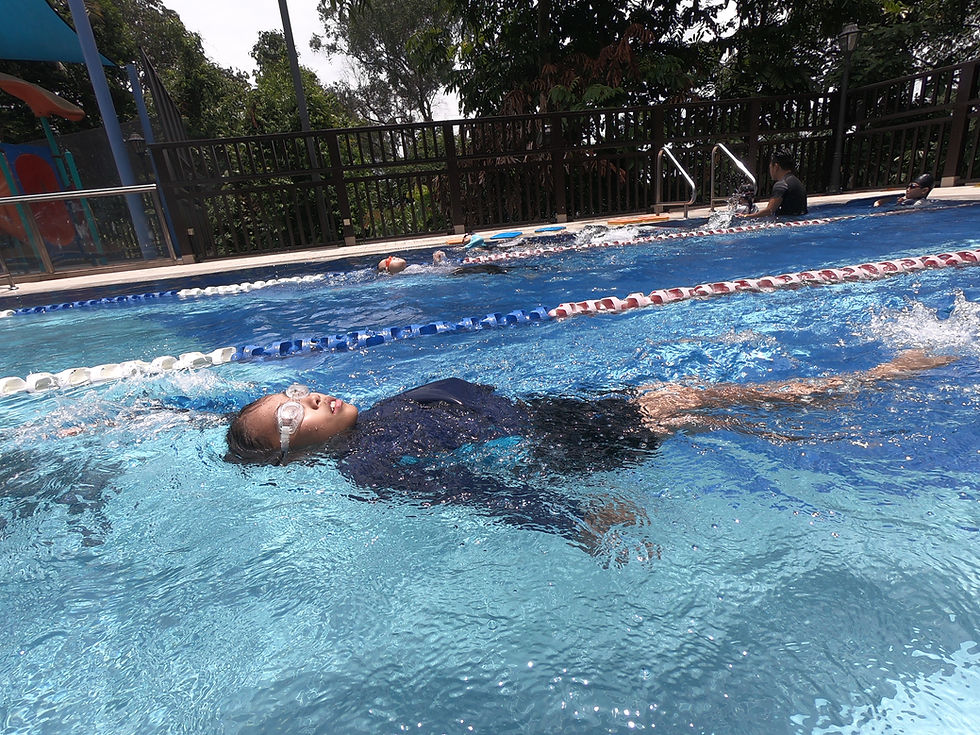Improving Your Backstroke Technique for Advanced Performance
- SG Sink Or Swim

- Jul 16
- 3 min read

Breaststroke is a highly technical and timing-dependent stroke that requires coordination, power, and rhythm. While most training happens in a pool, breaststroke swimmers can benefit immensely from adapting their technique and conditioning to various water environments—including open water, lakes, ocean surf, and temperature-variable conditions.
Whether you're preparing for a triathlon, an open water event, or want to build stroke versatility, training in different environments can elevate your performance, adaptability, and mental resilience.
🏊♂️ Why Train Breaststroke Beyond the Pool?
Different water environments challenge swimmers to:
Adjust stroke mechanics for changing resistance and depth
Develop stronger proprioception and body control
Improve endurance under unpredictable conditions
Sharpen mental focus and breathing efficiency
Increase adaptability for competitions or real-world swimming
🌊 1. Pool Training: Precision and Technique
Best for:
Building consistent stroke mechanics
Practicing drills and timing
Controlling variables like distance, temperature, and rest intervals
Key Focus Areas:
Stroke timing (pull ➝ breathe ➝ kick ➝ glide)
Streamline off the wall and pullouts
Turn technique and pacing strategies
Use tempo trainers and resistance tools for fine-tuning
Sample Drill:✅ Pull-Kick-Glide Drill — isolate each phase to improve timing and flow
🏞 2. Lake Training: Adaptability and Endurance
Challenges:
Low visibility
Varying water depth and temperature
No lane lines or walls
Training Goals:
Practice long, uninterrupted swims with consistent effort
Adapt breathing rhythm to longer durations
Improve sighting (even if not always needed in breaststroke)
Tips:
Focus on longer glides to conserve energy
Use brightly colored caps for visibility
Train with a group or spotter for safety
🌊 3. Ocean Training: Stability and Wave Management
Challenges:
Choppy or wavy surface
Salinity and buoyancy differences
Tides and currents
Training Goals:
Strengthen kick and balance in turbulent conditions
Shorten glide phase if waves disrupt timing
Develop a flexible breathing pattern depending on wave rhythm
Tips:
Adjust hand entry to be more direct and efficient
Use breaststroke kick to stabilize against lateral movement
Keep head movement minimal during breathing to maintain alignment
❄️ 4. Cold Water or Temperature Variability Training
Challenges:
Cold shock and muscle stiffness
Altered breathing patterns
Lower endurance and stroke control
Training Goals:
Build tolerance for colder conditions (gradual exposure recommended)
Focus on relaxed breathing and full exhalation
Practice quick, efficient stroke cycles to stay warm
Safety Tips:
Always swim with supervision in cold water
Use wetsuits if necessary
Warm up slowly post-swim to avoid hypothermia
💡 Technique Adjustments by Environment
Environment | Glide Length | Breathing | Stroke Rhythm | Kick Strength |
Pool | Long and controlled | Precise timing | Even and smooth | Moderate |
Lake | Moderate, energy-efficient | Steady and rhythmic | Slower tempo | Steady |
Ocean | Shorter, more frequent | Adaptive to waves | Quicker stroke rate | Strong for balance |
Cold Water | Shorter, tighter | Shallow and relaxed | Efficient, less pause | Consistent |
🔁 How to Integrate Environment-Based Training into Your Week
Sample Weekly Plan:
Monday: Pool — Technique drills + interval training
Wednesday: Lake — Distance swim with consistent effort
Friday: Pool — Pullouts, turns, and stroke-rate work
Saturday: Ocean (if available) — Stability, short sprints, and wave adjustment drills
🧠 Final Thoughts
Training breaststroke in a variety of environments builds a more complete swimmer — one who can maintain stroke integrity under pressure, adapt to unpredictable conditions, and stay mentally sharp across any swim setting. Whether you're a competitor or a recreational athlete, venturing beyond the pool makes you stronger, smarter, and more confident in your abilities.





Comments